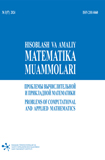Lagrangian model for dispersed phase motion in the turbulent atmosphere
Keywords:
particle trajectory, atmosphere, turbulent flow, drag, particle relaxation time, radioactive decay, mathematical model, computational algorithmAbstract
The analysis and prediction of pollutant dispersion in the atmosphere continue to be crucial areas of environmental research. Mathematical models are the most effective tools for identifying and understanding the complex dynamics of mass transfer processes in the atmosphere. Lagrangian Particle Dispersion Models are among the most widely utilized in air pollutants transport modeling. This paper deals with development of Lagrangian model for simulating the atmospheric dispersion of radioactive particles as well as computational algorithm for the problem aproximate solution. The model incorporates critical elements such as the influence of turbulent air flow parameters, the physical properties of the particles, and the effects of radioactive decay. The practical utility of the developed model, algorithm, and accompanying software is demonstrated through their ability to simulate pollutant emissions from a stationary point source and to map the trajectories of these particles over a specified time frame. The results of the modeling can provide insights into the potential environmental impacts of hazardous emissions.
References
Vallero D. Fundamentals of Air Pollution. – 5th ed. – Amsterdam: Academic Press, 2014. – 986 p.
Ganshin A. et al. A global coupled Eulerian-Lagrangian model and 1Ö1 km CO2 surface flux dataset for high-resolution atmospheric CO2 transport simulations // Geoscientific Model Development. – 2012. – Vol. 5. – P. 231-243. – doi: http://dx.doi.org/10.5194/gmd-5-231-2012.
Bellasio R., Bianconi R., Mosca S., Zannetti P. Formulation of the Lagrangian particle model LAPMOD and its evaluation against Kincaid SF6 and SO2 datasets // Atmospheric Environment. – 2017. – Vol. 163. – P. 87-98. – doi: http://dx.doi.org/10.1016/j.atmosenv.2017.05.039.
Stohl A. et al. Technical Note : The Lagrangian particle dispersion model FLEXPART version 6.2 // Atmospheric Chemistry and Physics. – 2005. – Vol. 5. – P. 2461-2474.
Лукьянов А.Н. и др. Глобальная атмосферная лагранжева модель рассеяния частиц // Известия Российской академии наук. Физика атмосферы и океана. – 2015. – Т. 51, №5. – С. 570-577. – doi: http://dx.doi.org/10.7868/S0002351515040070.
Peri´a˜nez R. et al. Some considerations on the dependence to numerical schemes of Lagrangian radionuclide transport models for the aquatic environment // Journal of Environmental Radioactivity. – 2023. – Vol. 261. – doi: http://dx.doi.org/10.1016/j.jenvrad.2023.107138.
Sinha V., Atikler M., Mileski M. Atmospheric dispersion of radioactive materials for radiological risk assessment in case of hypothetical sodium cooled fast reactor accident // Nuclear Engineering and Design. – 2024. – Vol. 422. – doi: http://dx.doi.org/10.1016/j.nucengdes.2024.113124.
Schiller L., Naumann Z. A drag coefficient correlation // VDI Zeitung. – 1935. – Vol. 77. –P. 318-320.
Wilcox D.C. Turbulence modeling for CFD. – 3rd ed. – La Ca˜nada: DCW Industries, 2006. – 522 p.
Ахмедов Д.Д., Убайдуллаев М.Ш., Насруллаев П.А. Простая лагранжева модель распространения радиоактивных частиц в атмосфере // Проблемы вычислительной и прикладной математики. – 2024. – №1(55). – С. 26-47.
Equations of Motion for Particles // ANSYS FLUENT Documentation / ANSYS Inc. –2009. – Режим доступа: https://shorturl.at/aetSY (дата обращения: 08.04.2024).
Israel R., Rosner D.E. Use of a Generalized Stokes Number to Determine the Aerodynamic Capture Efficiency of Non-Stokesian Particles from a Compressible Gas Flow // Aerosol Science and Technology. – 1982. – Vol. 2. – P. 45-51. – doi: http://dx.doi.org/10.1080/02786828308958612.
Климов А.Н. Ядерная физика и ядерные реакторы. – М.: Энергоатомиздат, 1985. – 352 с.
Basu S. Vertical wind speed profiles in atmospheric boundary layer flows // Wind Energy Engineerin / Ed. T.M. Letcher. – 2nd ed. – Academic Press, 2023. – 566 p. – doi: http://dx.doi.org/10.1016/C2021-0-00258-3.





